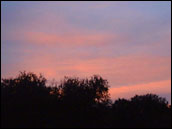

 | |||
When crops, rangeland, and managed forests come down with diseases, farmers and ranchers all over the world sometimes choose to burn the diseased fields in an attempt to sterilize the area, giving little thought to the smoke that can spread hundreds of miles away. A high school student working on a back yard science project now has pretty clear evidence that such fires may not kill everything we thought. In samples of the smoke from massive fires in Central America that reached Texas in the spring of 2002, she found living fungal spores that were perfectly able to start new colonies. This surprising discovery from a young, amateur scientist has the potential to change the prevailing wisdom on the benefits of burning diseased crops or timber. |
|||

Rainbows of DustWhen Sarah Mims discovered that smoke drifting across the Gulf of Mexico from fires in Central America was bringing fungal spores to the air around her home Seguin, Texas, she was definitely surprised. When Mims set out microscope slides and a continuous-operation air filter on a deer stand in her family's yard, she expected to get a collection of dust samples that she could check for the presence of fungus and bacteria. |
Sarah Mims, a teenager from Seguin, Texas, is studying the smoke and dust that arrive over her hometown from thousands of miles away. By her senior year in high school, she had already made some surprising discoveries. (Photograph by Forrest M. Mims III) | ||
“I was initially just planning to follow up on my project from the previous summer,” says Mims. In 2001, when she was in the 10th grade, Mims had decided to study the aerosols in her hometown. When most people think of aerosols, they think of hairspray or deodorant. But aerosols can be any small liquid or solid particle suspended in the air, including sea salt, volcanic ash, smoke, and dust. Mims had read that dust from the Sahara Desert, more than 4,000 kilometers away in North Africa, could be blown all the way over the Atlantic Ocean to North and South America. In the summer of 2001 numerous dust events in Florida and Texas created colorful sunsets and layered a thin blanket of dust on car windshields. Of course, Texas itself can be a dusty place. “I wanted to find out whether the dust was local, or whether some of it could be coming from the Sahara,” says Mims. |
 Spectacular sunsets are caused by small particles in the air called aerosols. In the summer of 2001, dust blown from the Sahara Desert frequently contributed to brilliantly colored evening skies over Texas. (Photograph by Sarah A. Mims) | ||
Mims analyzed the particles caught on her microscope slides using a cross-polarized light source that makes dust particles made out of quartz—a characteristic of Saharan dust—glitter with all the colors of the rainbow. Since the local dust, from a kind of soil called caliche that is common in South Texas, doesn’t change color under polarized light, Mims knew that the sparkling, shimmering dust she had collected wasn’t from Texas. Her description of the dust particles carries a sense of wonder and appreciation for nature’s magic that often seems missing from the world of grown-up, professional science. “They were really pretty,” she says, “like rainbows.” Mims also measured the size of the particles and took pictures of them, which she compared to pictures of Saharan Dust particles that she found in books. “They looked just alike,” she said. |
 Using a microscope Mims found that the particles she captured in Texas matched published images of Saharan dust. (Micrograph by Sarah A. Mims) | ||
 |
Dust, smoke, and other aerosols move all around the world. This map of aerosol optical depth (calculated by computer models) shows the dust storms in the Sahara Desert that brought dust all the way to the United States on July 26, 2001. Click on the image to see the movements of aerosols in June, July, and August of 2001. (Image and animation by Robert Simmon, based on GOCART Data) | ||
As her final piece of evidence, Mims used satellite observations of aerosols from the Sea-viewing Wide Field-of-View Sensor (SeaWiFS), the Total Ozone Mapping Spectrometer (TOMS), and the Advanced Very High Resolution Radiometer (AVHRR), combined with models of the atmosphere from the National Oceanic and Atmospheric Administration that showed the “back trajectory” of the air that was sitting over Texas on the days her samples and the satellite images were captured—in other words, where the air had been before it got to Texas. On the days when her filters were dirtiest and her microscope slides were covered with the most particles, the satellite images showed lots of aerosols over the region, and the back trajectory maps showed the air was coming from North Africa. Putting all these pieces together, says Mims, “It was obvious that the dust was Saharan Dust.” The data used in this study are available in one or more of NASA's Earth Science Data Centers. |
 Mims used back traces—specialized computer models—to track where the air over Seguin, Texas, came from on the days she gathered samples. On July 26, 2001, the air over her home had arrived from the Gulf of Mexico—the classic track of air currents arriving from Africa. Red triangles indicate the position of the air every 6 hours, to a maximum of 72 hours. (Image courtesy NOAA Air Resources Laboratory) | ||